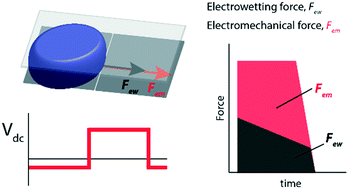Digital microfluidics using a differentially polarized interface (DPI) to enhance translational force†
Abstract
Direct current (DC)-digital microfluidics (DMF) enables the manipulation of droplets to revolutionize medical diagnostics, environmental assays, and fundamental biology. However, DC-DMF requires high voltages to generate droplet motion, which often breaks dielectric layers at the micro/nano scale, causing electrolysis. To minimize these issues, oil-fillers are commonly used to decrease the voltage requirement by reducing the surface tension of the droplet to the surrounding fluid. However, these oil-fillers increase DC-DMF complexity and decrease versatility. In this study, by adapting a differentially polarized interface (DPI) to generate an effective electromechanical force, the voltage required to manipulate a droplet was reduced from 600 V to 85 V without an oil-filler or special dielectric materials. By analyzing the temporal profiles of the contact angles during droplet motion under this DPI condition, this study, for the first time, distinguished the contributions of electrowetting and electromechanical forces to the translational movement of droplets. Dominant contribution of electrowetting is observed at the initial stage of the droplet translation with 52.8% reduction in the advancing contact angle and 20% reduction in the receding contact angle. However, after saturation in the temporal change of the contact angle, the effect of electrowetting contribution gradually decreases and electromechanical forces predominate. DPI-based digital microfluidics reduces the overall cost and complexity of stand-alone DC-DMF platforms, enabling filler-less and low-voltage applications for manipulating a wide range of liquid samples.



 Please wait while we load your content...
Please wait while we load your content...